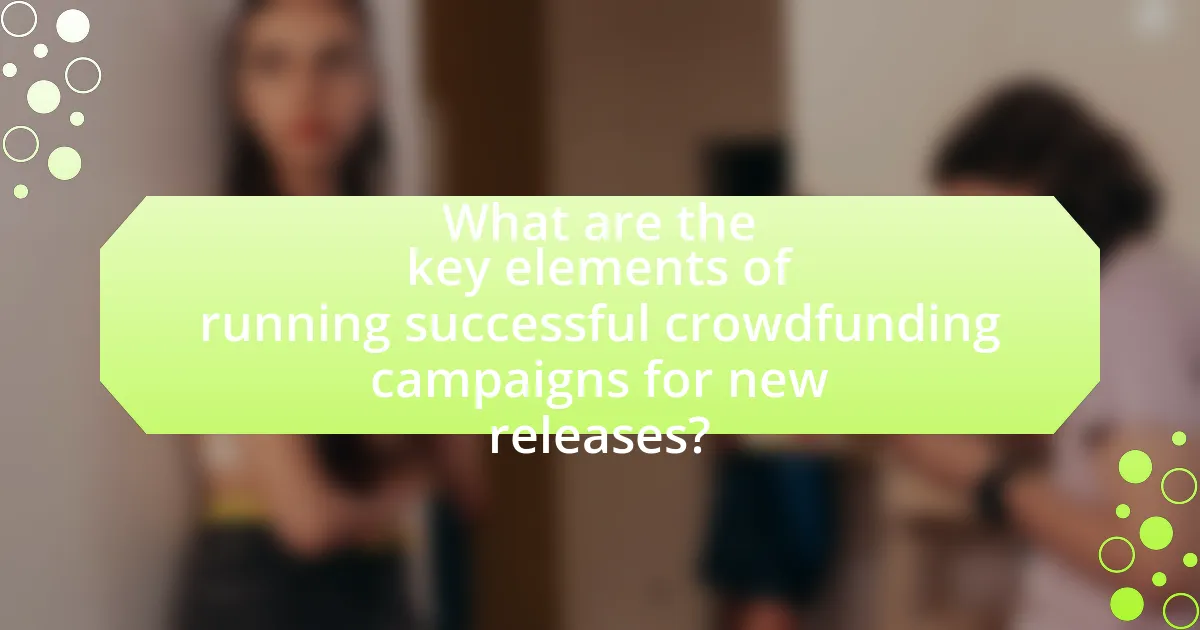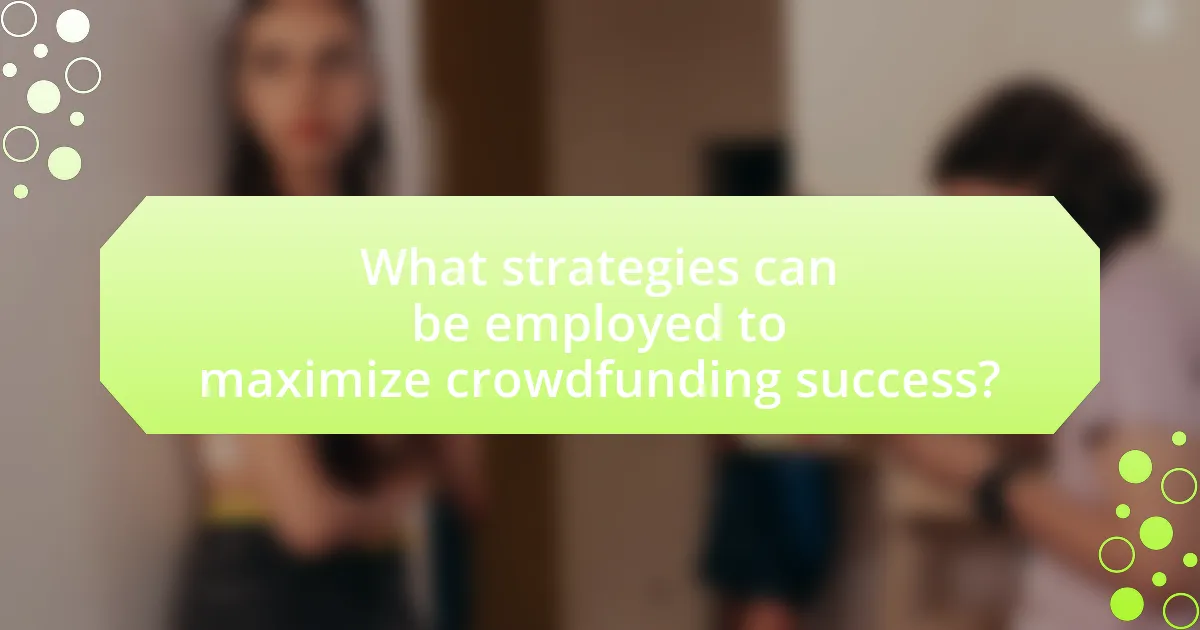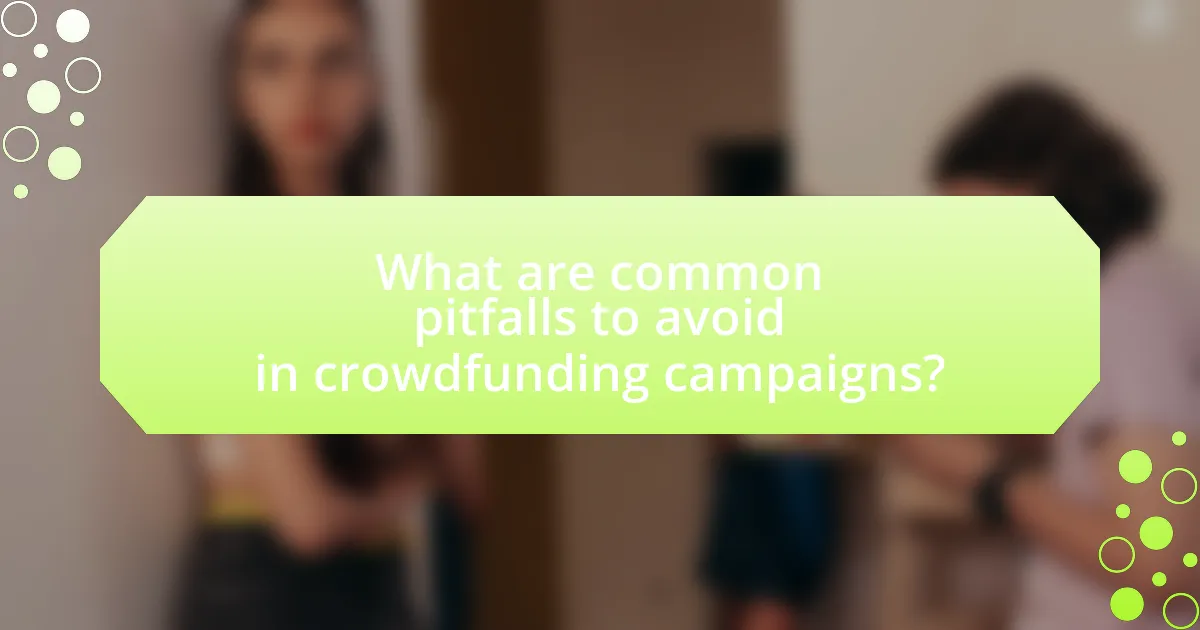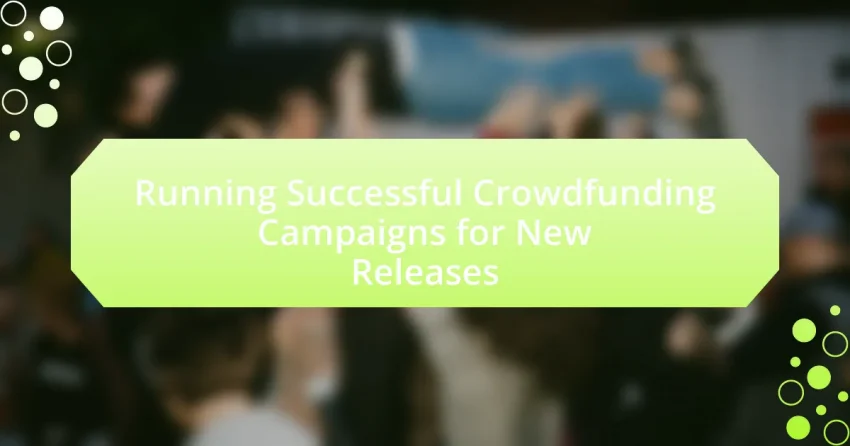The article focuses on the essential elements for running successful crowdfunding campaigns for new releases. Key components include crafting a compelling project narrative, identifying a well-defined target audience, implementing effective marketing strategies, and offering attractive rewards to backers. It defines success through metrics such as total funds raised, number of backers, and engagement levels, while also discussing the impact of clear goals and funding targets. Additionally, the article explores various crowdfunding platforms, the importance of audience engagement, and strategies to maximize campaign success, including pre-launch community building and effective communication with backers. Common pitfalls and best practices for post-campaign success are also addressed, providing a comprehensive guide for creators looking to launch successful crowdfunding initiatives.

What are the key elements of running successful crowdfunding campaigns for new releases?
The key elements of running successful crowdfunding campaigns for new releases include a compelling project narrative, a well-defined target audience, effective marketing strategies, and attractive rewards for backers. A compelling project narrative engages potential backers by clearly articulating the project’s purpose and vision, which is essential for building emotional connections. Identifying and understanding the target audience allows campaign creators to tailor their messaging and outreach efforts effectively, increasing the likelihood of support. Effective marketing strategies, such as leveraging social media, email campaigns, and partnerships, are crucial for reaching a broader audience and driving traffic to the campaign. Finally, offering attractive rewards incentivizes backers to contribute, with research indicating that campaigns with well-structured reward tiers often achieve higher funding success rates.
How do you define a successful crowdfunding campaign?
A successful crowdfunding campaign is defined by its ability to meet or exceed its funding goal within the specified timeframe. This success is often measured not only by the total amount raised but also by the number of backers, engagement levels, and the campaign’s ability to create a community around the project. For instance, campaigns that achieve at least 30% of their goal within the first week are statistically more likely to succeed, as indicated by research from the crowdfunding platform Kickstarter, which shows that early momentum significantly boosts overall funding outcomes.
What metrics indicate success in crowdfunding campaigns?
Successful crowdfunding campaigns are indicated by several key metrics, including total funds raised, number of backers, funding goal percentage achieved, and engagement rates. Total funds raised reflects the financial success of the campaign, while the number of backers demonstrates community support and interest. Achieving a high percentage of the funding goal, ideally within the first few days, indicates strong momentum and can attract additional backers. Engagement rates, such as social media shares and comments, further illustrate the campaign’s reach and effectiveness in connecting with potential supporters. These metrics collectively provide a comprehensive view of a campaign’s success and viability.
How do goals and funding targets influence campaign success?
Goals and funding targets significantly influence campaign success by providing clear benchmarks for progress and motivating backers. When a campaign sets specific, measurable goals, it creates a sense of urgency and accountability, encouraging potential supporters to contribute. Research indicates that campaigns with well-defined funding targets are 30% more likely to reach their goals, as they help to establish trust and credibility among backers. Additionally, achieving initial funding milestones can create momentum, attracting more contributions as the campaign progresses. This dynamic illustrates that clear goals and funding targets are essential for driving engagement and ultimately determining the success of crowdfunding campaigns.
What types of crowdfunding platforms are available for new releases?
There are several types of crowdfunding platforms available for new releases, including reward-based, equity-based, donation-based, and debt-based platforms. Reward-based platforms, such as Kickstarter and Indiegogo, allow creators to offer rewards to backers in exchange for their financial support. Equity-based platforms, like SeedInvest and Crowdcube, enable investors to receive shares in the company in return for their investment. Donation-based platforms, such as GoFundMe, focus on raising funds for charitable causes without offering financial returns. Debt-based platforms, like LendingClub, allow businesses to borrow money from investors with the promise of repayment with interest. Each type serves different needs and goals for creators launching new projects.
What are the differences between reward-based and equity-based crowdfunding?
Reward-based crowdfunding involves backers contributing funds in exchange for non-financial rewards, such as products or experiences, while equity-based crowdfunding allows investors to receive shares or ownership stakes in the company. In reward-based crowdfunding, platforms like Kickstarter and Indiegogo facilitate projects where backers support creators to receive tangible rewards, often before the product is available to the general public. In contrast, equity-based crowdfunding platforms like SeedInvest and Crowdcube enable startups to raise capital by offering equity, thus allowing investors to benefit from the company’s future profits and growth. This distinction is crucial as it affects the motivations of backers and investors, the regulatory environment, and the potential returns on investment.
How do platform fees and policies affect campaign choices?
Platform fees and policies significantly influence campaign choices by determining the financial viability and strategic approach of crowdfunding initiatives. High fees can deter creators from selecting certain platforms, as they reduce the net funds available for project execution. For instance, platforms like Kickstarter charge a 5% fee on funds raised, which can impact the total budget and pricing strategies for campaigns. Additionally, policies regarding funding thresholds, project approval, and promotional tools can shape how creators design their campaigns, influencing factors such as goal setting, marketing strategies, and reward structures. Consequently, understanding these fees and policies is crucial for creators to optimize their campaign planning and execution effectively.
Why is audience engagement crucial in crowdfunding campaigns?
Audience engagement is crucial in crowdfunding campaigns because it directly influences funding success and project visibility. Engaged audiences are more likely to contribute financially, share the campaign with their networks, and provide valuable feedback, which can enhance the campaign’s appeal. Research indicates that campaigns with higher engagement levels can raise up to 5 times more funds than those with minimal interaction, highlighting the importance of fostering a community around the project. Engaging potential backers through updates, social media interactions, and personalized communication creates a sense of ownership and investment in the project’s success, further driving contributions.
How can you identify and target your audience effectively?
To identify and target your audience effectively, conduct thorough market research to understand demographics, interests, and behaviors of potential backers. This involves utilizing tools like surveys, social media analytics, and competitor analysis to gather data on who is most likely to support your crowdfunding campaign. For instance, a study by Statista shows that 39% of crowdfunding backers are motivated by the desire to support new ideas, indicating that targeting innovators and early adopters can be beneficial. By segmenting your audience based on this data, you can tailor your messaging and outreach strategies to resonate with specific groups, increasing the likelihood of campaign success.
What strategies can enhance audience engagement during the campaign?
To enhance audience engagement during a crowdfunding campaign, utilizing interactive content such as polls, quizzes, and live Q&A sessions is effective. These strategies actively involve the audience, making them feel part of the campaign. For instance, campaigns that incorporate live interactions can increase engagement rates by up to 70%, as reported by a study from the Content Marketing Institute. Additionally, leveraging social media platforms to share behind-the-scenes content fosters a sense of community and transparency, which can lead to higher backer loyalty and participation.

What strategies can be employed to maximize crowdfunding success?
To maximize crowdfunding success, creators should focus on building a strong pre-launch community, crafting a compelling narrative, and offering attractive rewards. Engaging potential backers before the campaign starts creates anticipation and establishes a loyal supporter base, which is crucial for initial funding momentum. A well-crafted narrative that clearly communicates the project’s purpose and impact resonates with backers, increasing their emotional investment. Additionally, offering tiered rewards that provide value and exclusivity encourages higher contributions; research indicates that campaigns with well-structured reward systems can raise up to 50% more than those without.
How do you create a compelling campaign narrative?
To create a compelling campaign narrative, clearly define the core message and emotional appeal of the campaign. This involves identifying the target audience’s values and interests, then crafting a story that resonates with them, highlighting the problem your project addresses and the solution it offers. For instance, successful campaigns often utilize personal anecdotes or testimonials to establish authenticity and connection, as seen in the Pebble smartwatch campaign, which raised over $10 million by sharing the founder’s journey and the product’s impact on users. This approach not only engages potential backers but also fosters a sense of community and shared purpose, essential for driving support in crowdfunding initiatives.
What storytelling techniques resonate with potential backers?
Compelling storytelling techniques that resonate with potential backers include emotional engagement, authenticity, and clear value propositions. Emotional engagement captures the audience’s feelings, making them more likely to connect with the project; for instance, narratives that highlight personal journeys or challenges can evoke empathy and support. Authenticity builds trust, as backers prefer genuine stories over overly polished presentations; sharing behind-the-scenes insights or personal motivations can enhance this connection. Clear value propositions articulate the benefits and impact of the project, ensuring backers understand what they will gain or support, which is crucial for decision-making. Research indicates that campaigns that effectively utilize these techniques tend to achieve higher funding success rates, as they foster a deeper connection between creators and potential supporters.
How can visuals and videos enhance your campaign message?
Visuals and videos significantly enhance a campaign message by increasing engagement and retention of information. Research indicates that people retain 65% of information when it is paired with relevant visuals, compared to only 10% when presented in text alone. This is particularly crucial in crowdfunding campaigns, where capturing attention quickly is essential for success. Additionally, videos can convey emotions and narratives more effectively than text, leading to a stronger connection with potential backers. According to a study by Wyzowl, 84% of people say they’ve been convinced to buy a product or service by watching a brand’s video. Therefore, incorporating visuals and videos into a campaign can lead to higher engagement rates and increased funding.
What role does marketing play in crowdfunding campaigns?
Marketing plays a crucial role in crowdfunding campaigns by driving awareness, engagement, and funding. Effective marketing strategies, such as social media promotion, email outreach, and influencer partnerships, help to reach potential backers and create a compelling narrative around the project. According to a study by Indiegogo, campaigns that utilize social media effectively can raise up to 50% more funds than those that do not. Additionally, a well-executed marketing plan can establish credibility and trust, which are essential for encouraging contributions from backers.
How can social media be leveraged to promote your campaign?
Social media can be leveraged to promote your campaign by creating targeted content that engages your audience and encourages sharing. Utilizing platforms like Facebook, Instagram, and Twitter allows for direct interaction with potential backers, fostering community and excitement around the campaign. For instance, campaigns that use visually appealing posts and videos can increase engagement rates significantly; studies show that posts with images receive 94% more views than those without. Additionally, employing hashtags and collaborating with influencers can expand reach and visibility, driving traffic to the campaign page.
What are effective email marketing strategies for crowdfunding?
Effective email marketing strategies for crowdfunding include building a targeted email list, crafting compelling subject lines, personalizing content, and segmenting the audience. Building a targeted email list ensures that messages reach individuals interested in the project, increasing engagement rates. Compelling subject lines can improve open rates; for instance, emails with personalized subject lines have been shown to increase open rates by 26%. Personalizing content, such as addressing recipients by name and tailoring messages to their interests, enhances connection and response. Segmenting the audience allows for more relevant messaging, as different groups may have varying motivations for supporting a crowdfunding campaign. According to a study by Mailchimp, segmented campaigns can lead to a 14.31% higher open rate compared to non-segmented campaigns.
How can you build a community around your crowdfunding project?
To build a community around your crowdfunding project, actively engage with potential backers through social media, email newsletters, and community forums. This engagement fosters a sense of belonging and encourages participation. Research indicates that projects with strong community involvement see up to 50% more funding than those without. By sharing updates, responding to comments, and creating interactive content, you can cultivate a loyal supporter base that feels invested in the project’s success.
What platforms are best for community engagement and updates?
The best platforms for community engagement and updates are social media networks, email newsletters, and dedicated community forums. Social media platforms like Facebook, Twitter, and Instagram allow for real-time interaction and sharing of updates, which fosters community involvement. Email newsletters provide a direct line of communication to supporters, ensuring they receive timely information about campaign progress and events. Dedicated community forums, such as Discord or Reddit, create spaces for deeper discussions and feedback, enhancing engagement. These platforms have been shown to increase participation and support in crowdfunding campaigns, as they facilitate ongoing dialogue and connection among backers.
How can backer feedback be integrated into the campaign process?
Backer feedback can be integrated into the campaign process by actively soliciting input through surveys, comments, and direct communication channels. This approach allows campaign creators to gather insights on backer preferences and concerns, which can inform adjustments to the campaign strategy, product features, and marketing messages. For instance, a study by Indiegogo found that campaigns that engaged with backer feedback saw a 20% increase in funding success compared to those that did not. By incorporating this feedback loop, creators can enhance backer satisfaction and improve overall campaign outcomes.

What are common pitfalls to avoid in crowdfunding campaigns?
Common pitfalls to avoid in crowdfunding campaigns include inadequate planning, lack of marketing strategy, and failure to engage backers. Inadequate planning can lead to unrealistic funding goals and poorly defined project timelines, which often result in campaign failure. A lack of marketing strategy means that potential backers may not be aware of the campaign, leading to low visibility and engagement. Additionally, failure to engage backers can diminish trust and interest, as backers expect regular updates and communication throughout the campaign. According to a study by the University of Pennsylvania, campaigns that actively engage with their backers are 50% more likely to succeed.
What mistakes do creators often make when launching campaigns?
Creators often make the mistake of underestimating the importance of thorough market research when launching campaigns. This oversight can lead to misaligned target audiences and ineffective messaging, ultimately resulting in lower engagement and funding. For instance, a study by the University of Pennsylvania found that campaigns with well-defined target demographics raised 50% more funds than those without clear audience insights. Additionally, creators frequently neglect to build a pre-launch community, which is crucial for generating initial momentum; campaigns that engage potential backers before launch tend to perform significantly better.
How can unrealistic funding goals hinder campaign success?
Unrealistic funding goals can significantly hinder campaign success by discouraging potential backers and creating a perception of unachievability. When funding targets are set too high, they may lead to a lack of confidence among supporters, who might feel that their contributions will not make a meaningful impact. Research indicates that campaigns with achievable goals are 20% more likely to reach their funding targets compared to those with overly ambitious goals. Additionally, unrealistic expectations can result in campaign fatigue, where backers lose interest if they perceive that the project is unlikely to succeed. This can ultimately lead to lower engagement and fewer contributions, undermining the overall viability of the campaign.
What are the consequences of poor communication with backers?
Poor communication with backers can lead to decreased trust and support for a crowdfunding campaign. When backers feel uninformed or neglected, they may withdraw their financial support or choose not to back future projects. Research indicates that 70% of backers prioritize communication and updates, and a lack of transparency can result in negative perceptions of the project, ultimately affecting its success. Additionally, poor communication can lead to misunderstandings about project timelines and deliverables, causing frustration among backers and damaging the project’s reputation.
How can you manage risks associated with crowdfunding?
To manage risks associated with crowdfunding, implement a comprehensive risk assessment strategy that includes thorough market research, clear communication with backers, and contingency planning. Conducting market research helps identify potential challenges and audience interest, which can inform project viability. Clear communication ensures that backers are aware of project timelines, potential delays, and funding usage, fostering trust and transparency. Additionally, developing contingency plans prepares for unforeseen circumstances, such as budget overruns or production delays, thereby minimizing negative impacts on the campaign. These strategies collectively enhance the likelihood of a successful crowdfunding campaign.
What contingency plans should be in place for potential setbacks?
Contingency plans for potential setbacks in crowdfunding campaigns should include a clear communication strategy, budget reallocations, and alternative funding sources. Establishing a communication strategy ensures that backers are informed about any delays or issues, maintaining trust and transparency. Budget reallocations allow for flexibility in addressing unexpected costs, such as production delays or increased shipping fees. Additionally, identifying alternative funding sources, such as personal savings or partnerships, can provide financial support if the campaign falls short of its goals. These measures are essential for mitigating risks and ensuring the campaign’s success despite unforeseen challenges.
How can transparency build trust with backers during the campaign?
Transparency builds trust with backers during a campaign by providing clear, honest communication about project goals, progress, and challenges. When campaign creators share regular updates, financial details, and respond to backer inquiries promptly, they demonstrate accountability and foster a sense of partnership. Research indicates that campaigns with transparent practices tend to achieve higher funding success rates, as backers feel more secure in their investment when they are informed about how their contributions are being utilized and the overall status of the project.
What are the best practices for post-campaign success?
The best practices for post-campaign success include thorough communication with backers, timely fulfillment of rewards, and comprehensive analysis of campaign performance. Effective communication fosters trust and keeps backers informed about the project’s progress, which is crucial for maintaining a positive relationship. Timely fulfillment of rewards is essential, as delays can lead to dissatisfaction and damage the project’s reputation. Analyzing campaign performance through metrics such as funding sources, backer demographics, and engagement levels provides insights that can inform future campaigns and improve strategies. These practices are supported by research indicating that strong post-campaign engagement can enhance backer loyalty and increase the likelihood of future support.
How do you fulfill rewards and maintain backer relationships after funding?
To fulfill rewards and maintain backer relationships after funding, project creators should establish a clear timeline for reward delivery and maintain consistent communication with backers. This involves sending regular updates about the project’s progress, addressing any potential delays transparently, and providing detailed information about how and when rewards will be distributed. Research indicates that 70% of backers appreciate regular updates, which fosters trust and engagement. By prioritizing transparency and communication, creators can enhance backer satisfaction and encourage ongoing support for future projects.
What steps should be taken to transition from crowdfunding to product launch?
To transition from crowdfunding to product launch, first, fulfill all obligations to backers by delivering promised rewards and maintaining clear communication. This step is crucial as it builds trust and ensures backers feel valued, which can lead to positive word-of-mouth and future sales. Next, finalize product development based on feedback received during the crowdfunding campaign, ensuring that the product meets market expectations. Following this, establish a production plan that includes sourcing materials, manufacturing timelines, and quality control measures to ensure a smooth launch. Additionally, create a marketing strategy that leverages the existing community of backers while reaching out to a broader audience through social media, email campaigns, and press releases. Finally, set a launch date and prepare for distribution logistics to ensure timely delivery to customers. These steps are validated by successful case studies of crowdfunding campaigns that effectively transitioned to market, such as Pebble Technology, which emphasized backer engagement and product refinement before launch.
What practical tips can enhance your crowdfunding campaign?
To enhance your crowdfunding campaign, focus on creating a compelling narrative that resonates with potential backers. A well-crafted story engages emotions and builds a connection, which is crucial for attracting support. Research indicates that campaigns with strong storytelling elements raise 20% more funds than those without. Additionally, utilize social media effectively to reach a broader audience; campaigns that leverage social platforms see a 30% increase in backer engagement. Offering attractive rewards and maintaining regular updates also significantly boost backer trust and interest, leading to higher funding success rates.
How can you effectively utilize pre-launch strategies?
To effectively utilize pre-launch strategies, identify and engage your target audience early through social media, email marketing, and community building. Engaging potential backers before the launch creates anticipation and builds a supportive community, which is crucial for a successful crowdfunding campaign. Research shows that campaigns with a strong pre-launch presence can raise up to 50% more funds than those without, as they benefit from established interest and momentum.
What are the key elements of a successful campaign timeline?
The key elements of a successful campaign timeline include clear milestones, strategic planning, and effective communication. Clear milestones help track progress and ensure that the campaign stays on schedule, while strategic planning involves outlining specific tasks and deadlines to achieve campaign goals. Effective communication is essential for engaging backers and providing updates throughout the campaign. Research indicates that campaigns with well-defined timelines and regular updates tend to achieve higher funding success rates, as they maintain backer interest and trust.
